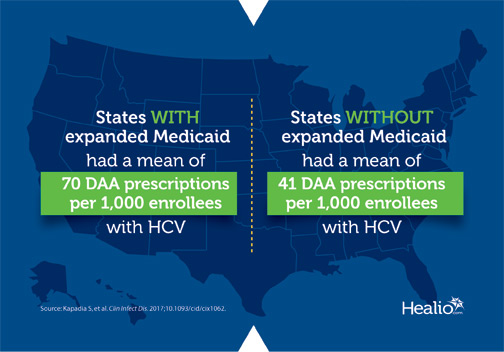States that relax Medicaid restrictions see increase in HCV treatment
State Medicaid programs that relaxed their treatment eligibility requirements for patients with hepatitis C virus infection demonstrated significantly increased treatment use from 2014 to 2016 compared with states that did not, a recently published analysis found.

Patients enrolled in Medicaid have a disproportionately high prevalence of HCV compared with those who use commercial insurance. After the introduction of Sovaldi (sofosbuvir, Gilead Sciences) in 2014, many state Medicaid programs introduced treatment restrictions, such as requiring abstinence from substance use, consultation with a specialist and that patients develop advanced liver fibrosis before seeking access to direct-acting antivirals (DAAs).
“Data from 2014 suggested that more restrictive criteria had a negative effect on DAA uptake,” Bruce R. Schackman, PhD, professor of health care policy and research at Weill Cornell Medical College, and colleagues wrote. “These policies, however, have evolved rapidly: by 2016, many Medicaid programs had changed one or more of these criteria, largely relaxing restrictions.”
The researchers reviewed data from the Medicaid Drug Utilization File between the second quarter of 2014 and the third quarter of 2016, a period immediately after the release of sofosbuvir but before the approval of all-oral DAA regimens, up to the most recent available data. The main outcome was the total DAA prescriptions per 1,000 nonelderly, Medicaid-enrolled adults with HCV. Policies requiring advanced fibrosis and proof of abstinence from substance use for access to DAAs were considered “high restriction,” whereas other policies without these requirements were considered having “low to no restriction.”
A total of 273,158 prescriptions were dispensed to Medicaid patients during the study period. Prescriptions declined from the second to fourth quarters of 2014, from 21,061 to 13,555, Schackman and colleagues wrote. The researchers attributed this decline to possible delays in treatment as clinicians waited for the DAA Harvoni (sofosbuvir/ledipasvir, Gilead Sciences) to become available. The number of prescriptions rose to 40,546 by the third quarter of 2016.
Twenty-eight states had known fibrosis requirements in both 2014 and 2016. Of these, 10 states made their policies less restrictive, two maintained low to no restriction and 16 maintained high restriction. Another 32 states had abstinence requirements; of these, five became less restrictive, four became more restrictive, four maintained low to no restriction and 19 maintained high restriction, the researchers reported. Two states became less restrictive in both categories, whereas 10 maintained high levels of restriction in both categories.
All changes in policy produced an increase in the use of DAAs, Schackman and colleagues wrote. However, states that relaxed their restrictions showed the most rapid increase. By the end of the study period, these states showed utilization rates comparable to those of states that had no to low restrictions.
Similarly, states that expanded Medicaid under the Affordable Care Act saw a significantly greater use of treatment than those that did not, Schackman and colleagues reported. The 31 states that expanded Medicaid had a mean of 70 prescriptions per 1,000 enrollees with HCV by the third quarter of 2016, compared with just 41 per 1,000 enrollees with HCV in states that chose not to expand Medicaid.
“Relaxation of Medicaid DAA treatment eligibility requirements in terms of disease severity and substance abuse abstinence may have contributed to increased treatment access for HCV-infected Medicaid enrollees,” the researchers wrote. “Despite the obvious implications for Medicaid program cost, this expansion is necessary to significantly reduce the burden of HCV-related mortality.” – by Andy Polhamus
Disclosures: The authors report no relevant financial disclosures.

